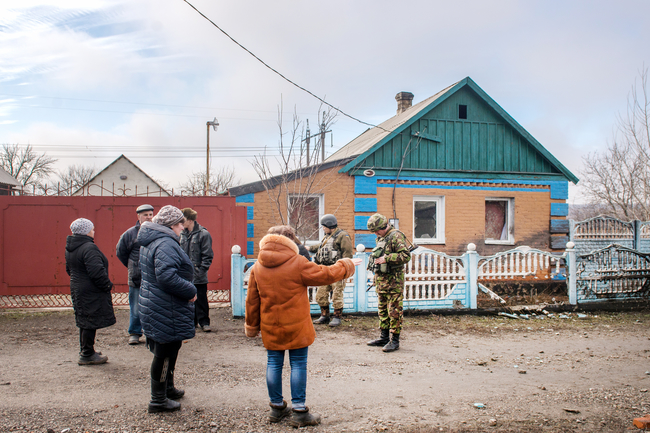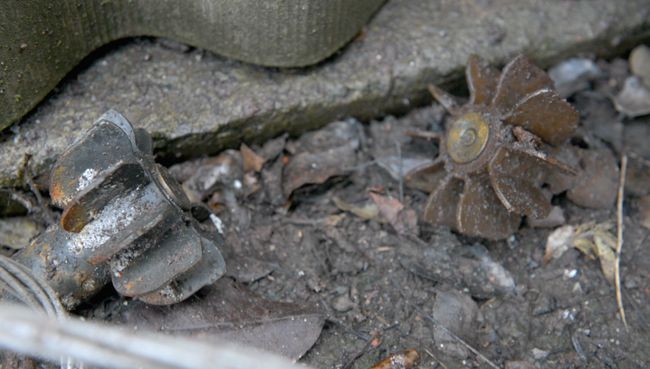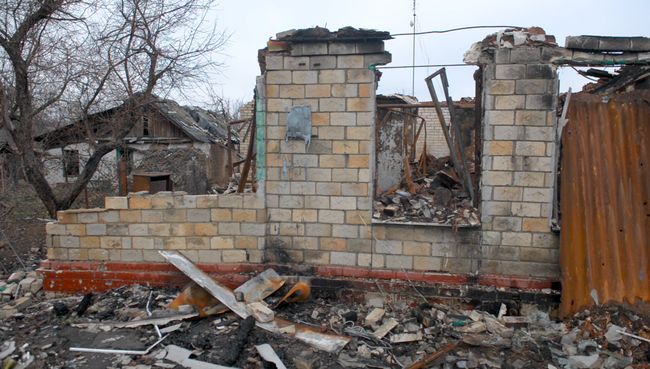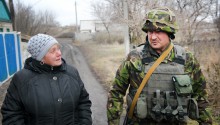Spring is in the air in the village of Zaitseve, a suburb of Horlivka. Mud squelches underfoot and the sky is blue above the roofs shattered by shells and perforated by splinters. The “green zone” stretching along the locals’ fields and gardens still stands bare, but it is fraught with peril: that’s a place where militias of the so-called DNR ambush. In the streets one can see Ukrainian troops: they patrol the territory and help the local people, who found themselves in conditions incompatible with normal life. The village has been cut off electricity and water supply for three months already. Each expedition to fetch food and medicines turns out to be an adventure which can end up a disaster. And the worst is the continuous shelling. “They used to shoot at fixed times, so we could at least do something in between the shelling, but now you never know where it will catch you,” shares a local woman.
The line of fire, or the front line, are not just military terms for the locals. It is literally a narrow stretch of earth, squeezed between the positions of the Ukrainian Army and those of the militias, which often coincides with one or another village street.

The village found itself in the “gray zone” back in the summer of 2014, and since then a considerable part of the population has left. Recently the hostilities have intensified, and the few remaining dwellers witness the village’s slow downfall.
PERCEPTION OF THE SITUATION
Journalists are treated with distrust, conversations are cautious, people ask not to be shown on television and prefer to remain anonymous. “I cannot let you see my cellar, where I and my old lady hide from shelling. You have nothing to do there,” says a 70-year-old man who eagerly showed shell-holes in his yard just minutes before. “It is a strategic location, so to speak.” Yet he does show it to us later. Just an ordinary cellar, nothing special. And there was nothing about our visit that could possibly harm the owner.

We can quite understand these people: they are frightened. This fear and uncertainty make their reality paradoxical. They try to speak well of both the Ukrainian troops, who share food with them and are stationed next door, and the militias of the so-called DNR, whose positions lie just outside these people’s fields. And minutes later they spit outrage at both. They can simultaneously speak of an undivided Ukraine and the “DNR” as of something quite logical and acceptable. But in the end they get totally confused and admit to have no idea about who shoots, where from, and who started this war. The only thing they want is to have no more shells dropped on their homes. They live in the “gray zone,” and that is where their perception of reality seems to have stuck.
“LIFE COMES TO A STANDSTILL AT FIVE IN THE AFTERNOON HERE”
The remaining villagers consist largely of older and sick people and of those who have nowhere else to go. Most families with children have left. The 70-year-old man tells that life in Zaitseve is unbearable, and it is hardly worth being called life, but he cannot leave: his wife is immobile. “It is very hard to pull my old lady into the cellar every time, and get her out after the shelling,” shares he. “But we have nowhere to go, and it is impossible to take along all our possessions. That is why we stayed. We get our medicines in Horlivka [in the occupied territory. – Author]. The shelling is constant, the house next door got hit twice already, and the dwellers finally left a couple of days ago. The entire village lies in ruin.”

We walk around the village. It is still and desolate. No children in the streets, no cattle grazing. To the left and to the right we can see fences, perforated with fine fragments or destroyed with projectiles, and here and there the remains of burned houses, charred cars, bikes, and children’s toys. A local woman in her mid-forties leads us around: “Here used to stand a house where a paralyzed woman lived. It got hit with a shell, everything burned down, we couldn’t even find her remains.” She brushes tears away and adds: “Life comes to a standstill at five in the afternoon here: the cannonade begins, and shells fly from all sides. No one wants us, neither Ukraine, nor those. We are just abandoned. Should our homes burn tomorrow, who will help us? No one…”
The woman leads us further along the streets. “Here,” she points to a little house with a hole in the roof, “here we furnished a cellar with a few entries and exits. Three families lived there a whole month, in August. And then a projectile hit the roof of the house and crashed into the floor! It did not break through, but we had the fright of our lives!”
“EACH AND EVERY CHURCH HOLIDAY IS ACCOMPANIED WITH CANNONADE”
Another villager, a woman about 60, tells that in her street with 56 houses only 12 families are living now. “Here each and every church holiday is accompanied with cannonade. We had to hid in the cellar almost all summer, starting from July. Bombardments, shooting. It is unbearable, what kind of life is it? We are exhausted,” and she burst out crying. “The OSCE came here more than once, but the hell remains.”

There is no water in the village, it has to be fetched from a well in the outskirts. And that only in the morning, because in the afternoon shelling begins. We see a man carrying two buckets on a shoulder yoke and another in his hand. Actually, the well lies on the line of sniper fire. Most people are afraid to go there, but this man risks his life to fetch water not only for his household, but also for his neighbors. “So I fetch it five or six times a day, and that only in the morning. I need a lot of water, I have a cow over there in the shed. I used to let her out to graze, but now I fear she might get shot.”

All of the remaining dwellers of Zaitseve have bags ready, packed with valuables and documents. As soon as cannonade begins, they grab them and take shelter in cellars. In the summer, the cellars were fit for staying, but not anymore. They are cold, damp, and dark. The smashed windows are covered with plastic or carpets, or blocked up with bricks. The yards are covered with rubble, bricks and pieces of corrugated roof sheets, glass shards crunch under our feet, the walking paths are covered with the bark of the pines which grow in every yard. No one will clean the mess up, it is pointless. Now or tonight, today or tomorrow shells will come flying again. People pick their fragments and fill buckets and wash-bowls with them. And yet they believe peace will come. If not, they will have to leave. A local woman says: “Many have relatives in nearby villages and towns, or in the so-called DNR. You must understand that it is not our choice. It is not us who began this war.”








